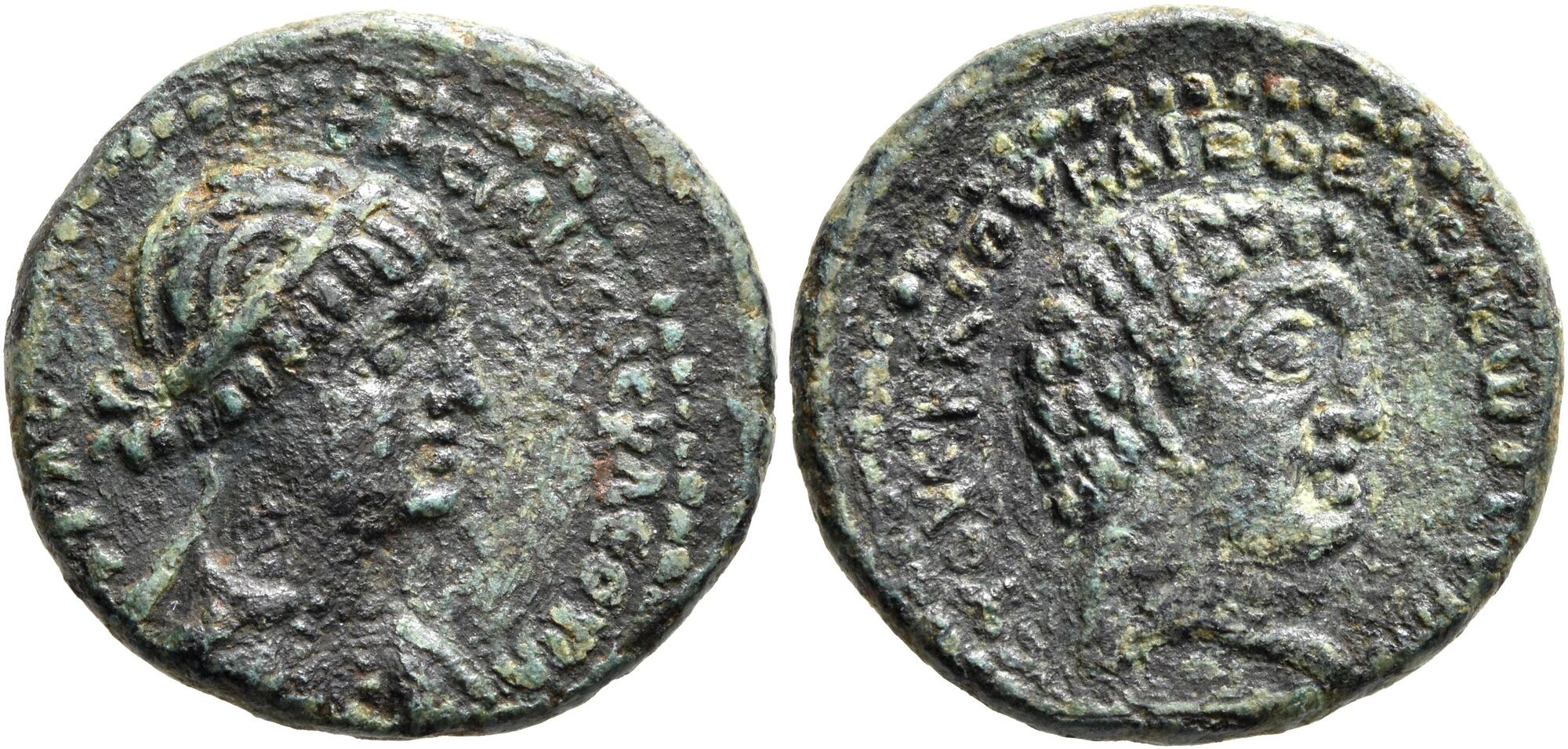Chalcis sub Libano (Cleopatra VII and Antony), bronze, ca 9g (Cleopatra/Antony) (32-31 BCE)
From SILVER
32 BCE - 31 BCE Bronze
Description
| ObverseInscription or printing placed on the obverse.: | ΒΑϹΙΛΙϹϹΗϹ ΚΛЄΟΠΑΤΡΑϹ (Greek).Diademed and draped bust of Cleopatra to right. |
| ReverseInscription or printing placed on the reverse.: | ЄΤΟΥϹ ΚΑ ΤΟΥ ΚΑΙ ς ΘЄΑϹ ΝЄⲰΤЄΡΑϹ (Greek).Bare head of Mark Antony to right |
Mint and issuing power
| MintIdentifies the place of manufacture or issue of a numismatic object.: | Chalcis sub Libano | Ancient regionAncient region.: | Phoenicia | Modern countryModern country: Lebanon | AuthorityIdentifies the issuing power. The authority can be "pretended" when the name or the portrait of X is on the coin but he/she was not the issuing power. It can also be "uncertain" when there is no mention of X on the coin but he/she was the issuing power according to the historical sources: | Cleopatra VII Philopator (Ptolemaic queen, 51-30 BC), Marcus Antonius (Roman politician and general, member of the Second Triumvirate, 83-30 BC), Ptolemaic dynasty (323-30 BC), Roman Republic |
Chronology
| FromIdentifies the initial date in a range assigned in a numismatic context. | 32 BCE | toIdentifies the final date in a range assigned in a numismatic context.. | 31 BCE | PeriodTime period of the numismatic object.: Roman from 30 BC |
Physical description
| MetalThe physical material (usually metal) from which an object is made.: | Bronze |
Median weightMedian of the weights of numismatic objects (in grams). in grams | 9.00 | DenominationTerm indicating the value of a numismatic object. Examples: tetradrachm, chalkous, denarius.: | StandardStandard.: |
Image

S940 Chalcis ad libanum Cleopatra and Antony.jpg [1]
References
| Die study referencePublication of the study: | Olivier - Aumaître 20171Olivier - Aumaître 2017, n° 82-249 | ||
| Coin series referenceReference to coin series study: | HGC 92HGC 9, n° 1451, RPC I3RPC I, n° 4771 | ||
| Coin series web referenceCoin series web references: | |||
Obverse dies distribution
| FrequencyFrequency of specimen in distribution. ᵖ | Number of obversesNumber of obverse dies. ᵖ (o) | % (o) | Number of coinsNumber of coins. (n) | % (n) | Die nameName(s) of the die(s). |
| 1 | 10 | 58.82 | 10 | 8 | 3, 4, 5, 7, 9, 10, 11, 12, 13, 17 |
| 2 | 2 | 11.76 | 4 | 3.2 | 6, 8 |
| 4 | 1 | 5.88 | 4 | 3.2 | 15 |
| 17 | 1 | 5.88 | 17 | 13.6 | 16 |
| 18 | 1 | 5.88 | 18 | 14.4 | 1 |
| 19 | 1 | 5.88 | 19 | 15.2 | 14 |
| 53 | 1 | 5.88 | 53 | 42.4 | 2 |
| Total | 17 of 17 | 99.98 | 125 of 125 | 100 |
Reverse dies distribution
no distribution is available
Quantification
| Number of obversesNumber of obverse dies. ᵖ (o) | 17 | Number of singletons (o1)The number of singleton coins. ᵖ | 10 |
| Number of reverse diesNumber of reverse dies. (r) | 58 | Number of coinsNumber of coins. (n) | 125 |
| Coins per obverse dieNumber of coins per obverse die. (n/o) | 7.35 | Coins per reverse dieNumber of coins per reverse die. (n/r) | 2.16 |
| Reverse per obverse ratioRatio of obverse dies divided by reverse dies. (r/o) | 3.41 | Percentage of singletons (o1)number of coins (n) divided by the number of singletons (o1) ᵖ | 58.82 % |
| Original number of dies (O) (Carter 1983 formula)The estimation of the number of coins according to Carter 1983 ᵖ | 17.81 | Coins struck if 20,000 as average productivity per dieCoins made if the average productivity for obverses (according to Carter) is 20,000. ᵖ | 356,200 |
| Original number of dies (O) (Esty 2011 formula)The estimation of the number of coins according to the singleton formula in Esty 2011 ᵖ (O) | 19.68 | Survival rate if 20,000 as average productivity per dieSurvival rate if average productivity is 20,000. ᵖ | 0.00035 |
| Coverage (o = % of O) (Esty 1984 formula)Esty 1984 - coverage (% of O) ᵖ (o = % of O) | 92% | Die productivity if survival rate 1/2,000Average productivity if survival rate is 1/2,000. ᵖ | 14,037.06 |
| Weight of silver (in kg) if 20,000 coins per die (O = Carter formula)Carter 1983 * Median weight * 20000 (*10 if gold or electrum) ᵖ | n.a. | Die productivity if survival rate 1/5,000Average productivity if survival rate is 1/5,000. ᵖ | 35,092.64 |
Remarks
Most likely one single workstation
References
- ^ Olivier, Julien - Aumaître, Héloïse (2017), "Antoine, Cléopâtre et le Levant. Le témoignage des monnaies", in L. Bricault et alii (éd.), Rome et les provinces. Monnayage et histoire. Mélanges offerts à Michel Amandry, Bordeaux, p. 105-122
- ^ Hoover, Oliver D. (2009), Handbook of ancient Syrian coins : royal and civic issues, fourth to first centuries BC, The Handbook of Greek Coinage 9, Lancaster, lxix, 332 p.
- ^ Amandry, Michel - Burnett, Andrew - Ripolles, Pere Pau (1998), Roman provincial coinage. I. From the death of Caesar to the death of Vitellius (44 BC-AC 69), London-Paris, 2 vol., xvii + 812 p., 195 pl.